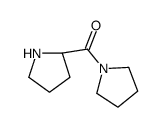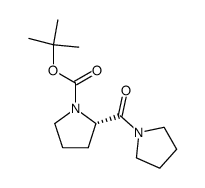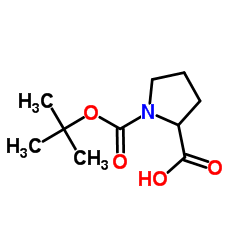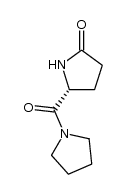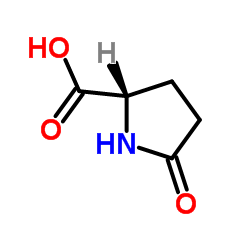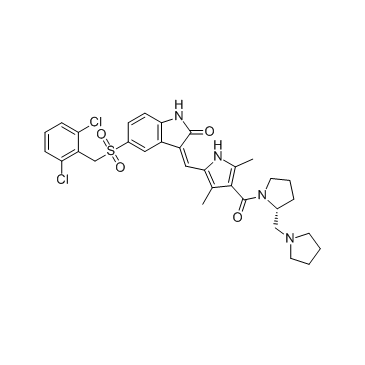60419-23-0
| 中文名 | (R)-(-)-1-(2-吡咯烷基甲基)吡咯烷 |
|---|---|
| 英文名 | (R)-(-)-1-(2-Pyrrolidinylmethyl)pyrrolidine |
| 英文别名 |
1-[(2R)-2-Pyrrolidinylmethyl]pyrrolidine
1-[(2R)-Pyrrolidin-2-ylmethyl]pyrrolidine (R)-(-)-1-(2-Pyrrolidinylmethyl)pyrrolidine Pyrrolidine, 1-[(2R)-2-pyrrolidinylmethyl]- Pyrrolidine, 2β-[(1-pyrrolidyl)methyl]- 1-[[(2R)-pyrrolidin-2-yl]methyl]pyrrolidine |
| 密度 | 1.0±0.1 g/cm3 |
|---|---|
| 沸点 | 265.8±0.0 °C at 760 mmHg |
| 分子式 | C9H18N2 |
| 分子量 | 154.253 |
| 闪点 | 87.8±0.0 °C |
| 精确质量 | 154.147003 |
| PSA | 15.27000 |
| LogP | 0.81 |
| 外观性状 | 液体;Colorless to Light yellow clear liquid |
| 蒸汽压 | 0.0±0.5 mmHg at 25°C |
| 折射率 | 1.500 |
| 储存条件 | 存放于惰性气体之中;避免空气 |
| 计算化学 | 1.疏水参数计算参考值(XlogP):0.9 2.氢键供体数量:1 3.氢键受体数量:2 4.可旋转化学键数量:2 5.互变异构体数量:无 6.拓扑分子极性表面积15.3 7.重原子数量:11 8.表面电荷:0 9.复杂度:119 10.同位素原子数量:0 11.确定原子立构中心数量:1 12.不确定原子立构中心数量:0 13.确定化学键立构中心数量:0 14.不确定化学键立构中心数量:0 15.共价键单元数量:1 |
|
(R)-(-)-1-(2-Pyrrolidinylmethyl)pyrrolidine
Revision number: 5
SAFETY DATA SHEET Section1. IDENTIFICATION Product name:(R)-(-)-1-(2-Pyrrolidinylmethyl)pyrrolidine Revision number:5 Section2. HAZARDS IDENTIFICATION GHS classification PHYSICAL HAZARDS Category 4 Flammable liquids HEALTH HAZARDS Category 2 Skin corrosion/irritation Serious eye damage/eye irritationCategory 2A Not classified ENVIRONMENTAL HAZARDS GHS label elements, including precautionary statements Pictograms or hazard symbols Signal wordWarning Hazard statementsCombustible liquid Causes skin irritation Causes serious eye irritation Precautionary statements: Keep away from flames and hot surfaces. [Prevention] Wash hands thoroughly after handling. Wear protective gloves and eye/face protection. [Response]IF IN EYES: Rinse cautiously with water for several minutes. Remove contact lenses, if present and easy to do. Continue rinsing. If eye irritation persists: Get medical advice/attention. IF ON SKIN: Gently wash with plenty of soap and water. If skin irritation occurs: Get medical advice/attention. Take off contaminated clothing and wash before reuse. [Storage]Store in a well-ventilated place. Keep cool. [Disposal]Dispose of contents/container through a waste management company authorized by the local government. Section3. COMPOSITION/INFORMATION ON INGREDIENTS Substance/mixture:Substance Components:(R)-(-)-1-(2-Pyrrolidinylmethyl)pyrrolidine Percent:>98.0%(GC)(T) 60419-23-0 CAS Number: Chemical Formula:C9H18N2 (R)-(-)-1-(2-Pyrrolidinylmethyl)pyrrolidine Section4. FIRST AID MEASURES Inhalation:Remove victim to fresh air and keep at rest in a position comfortable for breathing. Get medical advice/attention if you feel unwell. Skin contact:Remove/Take off immediately all contaminated clothing. Gently wash with plenty of soap and water. If skin irritation or rash occurs: Get medical advice/attention. Eye contact:Rinse cautiously with water for several minutes. Remove contact lenses, if present and easy to do. Continue rinsing. If eye irritation persists: Get medical advice/attention. Ingestion:Get medical advice/attention if you feel unwell. Rinse mouth. Protection of first-aiders:A rescuer should wear personal protective equipment, such as rubber gloves and air- tight goggles. Section5. FIRE-FIGHTING MEASURES Suitable extinguishingDry chemical, foam, water spray, carbon dioxide. media: Specific hazards arising Take care as it may decompose upon combustion or in high temperatures to from the chemical:generate poisonous fume. Precautions for firefighters: Fire-extinguishing work is done from the windward and the suitable fire-extinguishing method according to the surrounding situation is used. Uninvolved persons should evacuate to a safe place. In case of fire in the surroundings: Remove movable containers if safe to do so. Special protectiveWhen extinguishing fire, be sure to wear personal protective equipment. equipment for firefighters: Section6. ACCIDENTAL RELEASE MEASURES Use personal protective equipment. Keep people away from and upwind of spill/leak. Personal precautions, protective equipment and Ensure adequate ventilation. Entry to non-involved personnel should be controlled emergency procedures: around the leakage area by roping off, etc. Environmental precautions: Prevent product from entering drains. Methods and materials for Absorb spilled material in a suitable absorbent (e.g. rag, dry sand, earth, saw-dust). containment and cleaning In case of large amount of spillage, contain a spill by bunding. Adhered or collected up: material should be promptly disposed of, in accordance with appropriate laws and regulations. Prevention of secondary Remove all sources of ignition. Fire-extinguishing devices should be prepared in hazards:case of a fire. Use spark-proof tools and explosion-proof equipment. Section7. HANDLING AND STORAGE Precautions for safe handling Technical measures:Handling is performed in a well ventilated place. Wear suitable protective equipment. Prevent generation of vapour or mist. Keep away from flames and hot surfaces. Take measures to prevent the build up of electrostatic charge. Use explosion-proof equipment. Wash hands and face thoroughly after handling. Use a closed system, ventilation. Advice on safe handling: Avoid contact with skin, eyes and clothing. Conditions for safe storage, including any incompatibilities Keep container tightly closed. Store in a cool, dark and well-ventilated place. Storage conditions: Store under inert gas. Store away from incompatible materials such as oxidizing agents. Air-sensitive Comply with laws. Packaging material: Section8. EXPOSURE CONTROLS / PERSONAL PROTECTION Engineering controls:Install a closed system or local exhaust as possible so that workers should not be exposed directly. Also install safety shower and eye bath. Personal protective equipment (R)-(-)-1-(2-Pyrrolidinylmethyl)pyrrolidine Section8. EXPOSURE CONTROLS / PERSONAL PROTECTION Respiratory protection: Vapor respirator. Follow local and national regulations. Hand protection:Protective gloves. Eye protection:Safety glasses. A face-shield, if the situation requires. Skin and body protection: Protective clothing. Protective boots, if the situation requires. Section9. PHYSICAL AND CHEMICAL PROPERTIES Physical state (20°C):Liquid Form:Clear Colour:Colorless - Slightly pale yellow Odour:No data available pH: No data available Melting point/freezing point:No data available Boiling point/range:No data available Flash point:No data available Flammability or explosive limits: Lower:No data available Upper:No data available Relative density:No data available Solubility(ies): [Water]No data available [Other solvents]No data available Section10. STABILITY AND REACTIVITY Chemical stability:Stable under proper conditions. Possibility of hazardous No special reactivity has been reported. reactions: Open flame Conditions to avoid: Incompatible materials: Oxidizing agents Hazardous decomposition Carbon monoxide, Carbon dioxide, Nitrogen oxides (NOx) products: Section11. TOXICOLOGICAL INFORMATION Acute Toxicity:No data available Skin corrosion/irritation: No data available Serious eyeNo data available damage/irritation: Germ cell mutagenicity: No data available Carcinogenicity: IARC =No data available NTP =No data available Reproductive toxicity:No data available Section12. ECOLOGICAL INFORMATION Ecotoxicity: Fish:No data available No data available Crustacea: Algae:No data available Persistence / degradability: No data available BioaccumulativeNo data available potential(BCF): Mobility in soil No data available Log Pow: Soil adsorption (Koc):No data available No data available Henry's Law constant(PaM3/mol): (R)-(-)-1-(2-Pyrrolidinylmethyl)pyrrolidine Section13. DISPOSAL CONSIDERATIONS Recycle to process, if possible. Consult your local regional authorities. You may be able to burn in a chemical incinerator equipped with an afterburner and scrubber system. Observe all federal, state and local regulations when disposing of the substance. Section14. TRANSPORT INFORMATION Hazards Class:Does not correspond to the classification standard of the United Nations UN-No:Not listed Section15. REGULATORY INFORMATION Safe management ordinance of dangerous chemical product (State Council announces on January 26, 2002 and revised on February 16,2011): Safe use and production, the storage of a dangerous chemical, transport, loading and unloading were prescribed. SECTION 16 - ADDITIONAL INFORMATION N/A |
|
~90% 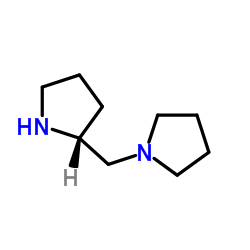
60419-23-0 |
| 文献:Costa, Brian R. de; Dominguez, Celia; He, Xiao-shu; Williams, Wanda; Radesca, Lilian; Bowen, Wayne Journal of Medicinal Chemistry, 1992 , vol. 35, # 23 p. 4334 - 4343 |
|
~54% 
60419-23-0 |
| 文献:Harrison; O'Brien Synthetic Communications, 2001 , vol. 31, # 8 p. 1155 - 1160 |
|
~% 
60419-23-0 |
| 文献:Journal of Medicinal Chemistry, , vol. 35, # 23 p. 4334 - 4343 |
|
~% 
60419-23-0 |
| 文献:Tetrahedron Asymmetry, , vol. 13, # 20 p. 2229 - 2234 |
|
~% 
60419-23-0 |
| 文献:Tetrahedron Asymmetry, , vol. 13, # 20 p. 2229 - 2234 |
|
~% 
60419-23-0 |
| 文献:Synthetic Communications, , vol. 31, # 8 p. 1155 - 1160 |
| 上游产品 6 | |
|---|---|
| 下游产品 1 | |


